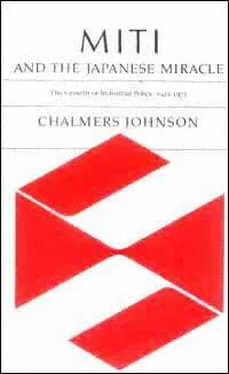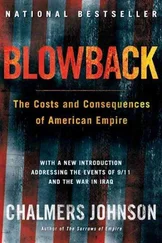Chalmers Johnson - MITI and the Japanese miracle
Здесь есть возможность читать онлайн «Chalmers Johnson - MITI and the Japanese miracle» весь текст электронной книги совершенно бесплатно (целиком полную версию без сокращений). В некоторых случаях можно слушать аудио, скачать через торрент в формате fb2 и присутствует краткое содержание. Год выпуска: 2007, Издательство: Stanford University Press, Жанр: Старинная литература, на английском языке. Описание произведения, (предисловие) а так же отзывы посетителей доступны на портале библиотеки ЛибКат.
- Название:MITI and the Japanese miracle
- Автор:
- Издательство:Stanford University Press
- Жанр:
- Год:2007
- ISBN:нет данных
- Рейтинг книги:3 / 5. Голосов: 1
-
Избранное:Добавить в избранное
- Отзывы:
-
Ваша оценка:
- 60
- 1
- 2
- 3
- 4
- 5
MITI and the Japanese miracle: краткое содержание, описание и аннотация
Предлагаем к чтению аннотацию, описание, краткое содержание или предисловие (зависит от того, что написал сам автор книги «MITI and the Japanese miracle»). Если вы не нашли необходимую информацию о книге — напишите в комментариях, мы постараемся отыскать её.
MITI and the Japanese miracle — читать онлайн бесплатно полную книгу (весь текст) целиком
Ниже представлен текст книги, разбитый по страницам. Система сохранения места последней прочитанной страницы, позволяет с удобством читать онлайн бесплатно книгу «MITI and the Japanese miracle», без необходимости каждый раз заново искать на чём Вы остановились. Поставьте закладку, и сможете в любой момент перейти на страницу, на которой закончили чтение.
Интервал:
Закладка:
On December 19, three weeks after Shirasu took over at the BOT, General MacArthur transmitted to the Japanese government his nine-point Economic Stabilization Plan. This called for a balanced budget, strengthened tax collection, limitations on RFB loans, improved controls over foreign trade and U.S. aid, increased production, and several other reforms that were intended to bring Japan back into international commerce but that would also impose very harsh conditions on the Japanese people until the exports started to flow. The immediate objective of the plan was to establish a fixed exchange rate. MacArthur made it clear that concrete policies to implement the nine principles were the responsibility of the Japanese government, but he added that the United States was sending an adviser to assist the government in its efforts and to monitor its progress. This adviser was the Detroit banker and former financial consultant to General Lucius D. Clay in Germany, Joseph Morrell Dodge (18901964).
Dodge arrived in February 1949 and, working with Yoshida's new minister of finance, Ikeda Hayato, he compelled the government to write an overbalanced budget. On April 25 he also established the official exchange rate of US$1 = ¥360 that was to last until 1971. He authorized the creation of the Japanese Export-Import Bank and the Japan Development Bank, and he supervised a host of other critical decisions that affected the Japanese economy for years to come. Dodge's most important achievement was the sudden, drastic curtailment of inflation through a draconian reduction of demandwhat Maeda has called "rationalization through unemployment" (
kubikiri
Page 191
gorika
*). Dodge once and for all ended the debate over increased production versus control of inflation by choosing the second. His policies are properly compared with the Matsukata deflation of the 1880's and with Inoue Junnosuke's deflationary lifting of the gold embargo in 1930. Moreover, just as Inoue's deflation was overcome by the war profits of the Manchurian Incident, so Dodge's deflation was overcome by the war profits of the Korean War beginning in 1950.
While these great events were taking place, and almost unnoticed by Dodge or any other SCAP official, the Japanese contributed to the nine-point stabilization plan a reform of their ownone that probably had as great an impact on the Japanese and world economies as any of Dodge's measures. They abolished MCI and the BOT and combined their former functions into a new ministry called the Ministry of International Trade and Industry. Shirasu Jiro* was the prime mover behind this development.
59
In retrospect it is clear that the merging of MCI and the BOTor, more precisely, the turning of the BOT into an internal bureau of MCI and giving it a prime position in the ministry's chain of commandwas a brilliant idea. But that it was Shirasu Jiro who had the idea and he and Yoshida who supervised its execution produced some of the most anxious days that the men of the "Kishi-Shiina line" had ever known in their bureaucratic lives.
Yoshida and Shirasu were genuinely committed to SCAP's program for the restoration of Japanese international trade, but they also were motivated by political and bureaucratic interests of their own in pushing the reform. As noted earlier, Yoshida had a deep aversion to MCI and to its close association with the controlled wartime economy and the military. Shirasu shared these views, and in addition he wanted to clean up what he claimed were corrupt practices in the BOT that he had discovered after taking office as director.
60
Yoshida planned to elevate both the Ministry of Finance (under his protégé Ikeda) and his own Ministry of Foreign Affairs to positions of greater influence in economic administration vis-à-vis MCI, and Yoshida as well as Shirasu believed that trusted Foreign Office people would be better at export promotion than the industrial policy bureaucrats. Thus, Shirasu's original idea was not so much to merge the BOT and MCI as it was to place a restaffed BOT inside MCI in order to reform it and keep it under control.
MCI officials were aware of these intentions of Yoshida and Shirasu, and they did what they could to forestall the worst. On February 2, 1949, they sent a comparatively young MCI official, Nagayama Tokio (class of 1935), to the BOT as chief of the Trade Section in the General Affairs Bureau; he was to keep tabs on Shirasu's plans. Unfor-
Page 192
tunately for MCI, this turned out to be one of the most abortive maneuvers its leaders ever undertook. Shirasu turned Nagayama around and made him one of his own lieutenants. Nagayama then returned to MITI, where he was dubbed "Emperor Nagayama," to become the first head of the MITI Secretariat (194953) and the official in charge of personnel appointments (the case of "Emperor Nagayama" is discussed further in Chapter 6).
Another thing the MCI officials did was to write the MITI Establishment Law (number 102, introduced in the Diet on April 22, 1949, passed on May 24, and implemented on May 25). In this law MCI tried to accommodate itself to the new order by putting the prefix "international trade" (
tsusho
*) in front of the name of each of its policy-making and industrial bureaus, the result being a series of odd-sounding titles like International Trade Enterprises Bureau (Tsusho* Kigyo* Kyoku), and so forth. They also grouped all of the bureaus in charge of energy problems into one separate external bureau, the Resources Agency (Shigen Cho*), to downplay their importance. The Resources Agency was abolished in 1952 in the sweeping restructuring of MITI that followed the end of the occupation, but it was reestablished in 1973, when energy policy once again became salient, as the Natural Resources and Energy Agency (Shigen Enerugi* Cho). All of these internal MITI arrangements were intended to reorient it away from MCI's emphasis on internal control and priority production and toward international trade and the promotion of exports; they also had the secondary purpose of trying to smuggle as much of the old MCI as possible past Shirasu's and Yoshida's scrutiny. (MITI's initial internal organization is detailed in Appendix B).
During early 1949 rumors circulated that Shirasu himself intended to become MITI's first vice-minister. This was the moment of truth for the old MCI. Its last vice-minister, Matsuda Taro*, undertook to negotiate personally with Shirasu to try to prevent this from happening. He succeeded through a compromise in which it was agreed that Matsuda would resign, that Nagayama would take over the Secretariat even though there were men senior to him in the ministry, and that the directors of the new International Trade Bureau (ITB; the old BOT reborn within MITI) would come from the Foreign Ministryin return for all of which MCI could name one of its own people as vice-minister (Matsuda named Yamamoto Takayuki, a "Kishi-Shiina line" official). As it turned out, the first four ITB directors were, in fact, very distinguished diplomatsnamely, Takeuchi Ryuji*, later ambassador to West Germany, who served from May to December, 1949;
Page 193
Oda * Takio, later ambassador to Indonesia, who served from December 1949 to June 1951; Ushiba Nobuhiko, later ambassador to the United States (197073) and in 1977 "minister of external economic relations" to deal with the U.S.-Japan trade crisis, who served from June 1951 to July 1954; and Itagaki Osamu, later ambassador to the Republic of China (Taiwan), who served from July 1954 to September 1956. It was against this backdrop of strong Foreign Office coloration that MITI came into being and Yamamoto began trying to rebuild the Kishi-Shiina line from within. Nonetheless, from the third Yoshida cabinet of February 1949 to the fall of the fifth Yoshida cabinet in December 1954, the prime minister named eight different people as MITI minister, only two of whom had any political clout at all (Ikeda, briefly, and Aichi Kiichi at the very end). This was, of course, Yoshida's way of showing that he still regarded MITI as of no political importance.
Читать дальшеИнтервал:
Закладка:
Похожие книги на «MITI and the Japanese miracle»
Представляем Вашему вниманию похожие книги на «MITI and the Japanese miracle» списком для выбора. Мы отобрали схожую по названию и смыслу литературу в надежде предоставить читателям больше вариантов отыскать новые, интересные, ещё непрочитанные произведения.
Обсуждение, отзывы о книге «MITI and the Japanese miracle» и просто собственные мнения читателей. Оставьте ваши комментарии, напишите, что Вы думаете о произведении, его смысле или главных героях. Укажите что конкретно понравилось, а что нет, и почему Вы так считаете.












